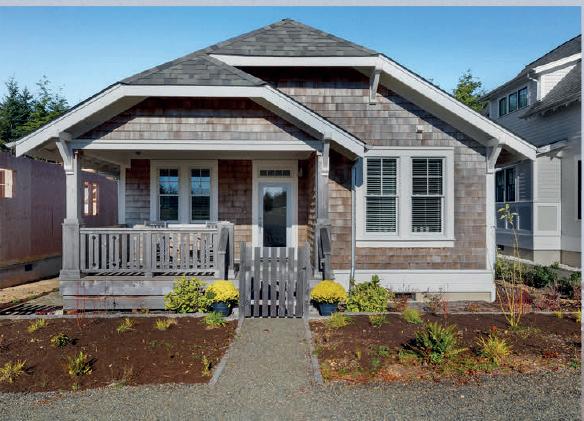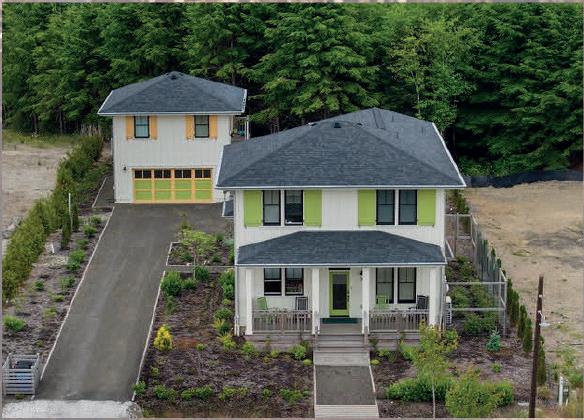SPOKE








4 A YEAR RIGHT HERE
Plan your 2026 calendar around Seabrook’s many seasonal events and activities.
8 WHERE TO EAT AND SHOP
Consider this your comprehensive guide to the town’s eateries and retailers. Plus, a few of our favorite products for purchase and a recipe for the very best clam chowder.
20 PEOPLE MAKE THE PLACE
Meet some of the locals that make Seabrook such a welcoming community.
28 PURPOSE BUILT
Find out more about the Seabrook Community Foundation’s ambitious philanthropic projects.
30 GREEN ACRES
Come along on a tour of Schultz Farm, bringing composting and locally grown veggies to town.
34 CENTER OF IT ALL
Get excited—Seabrook’s town center is nearing completion, adding gorgeous residences and double the number of shops.
38 ADVENTURE AWAITS
Explore the surrounding area by foot, bike, boat, or car. Plus, some local reading recommendations for when you’d rather stay in.
44 SEASHELLS AND WEDDING BELLS
Fall in love with a Chicago couple who got married in Seabrook last summer.
50 TRAIL MAP
Plan your trip into the woods with this map of nearby biking and hiking trails.
52 A PIECE OF HISTORY
Learn about how the local mural aimed to draw attention to an important former landmark.
seabrookwa.com
Every year, we put the finishing touches on the annual Spoke issue just as the leaves are falling and the first atmospheric river is moving in, when festive gourds make way for decorated evergreens and foragers head out in search of mushrooms and razor clams.
It’s the season when Seabrook calls to me most.
I’ve always been firmly on Team Shoulder Season when it comes to visiting my favorite Washington beach town. The broody storms, the crackling fires, the serenity and creativity, the lushness of the forest and monochromatic blue-gray seascape. It speaks to my inner house cat.
But this year, after more than 15 years of visiting Seabrook, I came during the summer. It’s pretty clear why it’s so popular to visit then—those endless hours of sunshine mean there’s a lot you can pack into a day, and with all the events going on (page 4), there’s plenty to choose from. Folks who love an adventure (page 38) can bike, hike, and paddle without a raincloud in sight. Kids, free from the confines of the school calendar, can roam in packs—plus, you can eat an ice cream cone in a tank top rather than a parka.

It made me think about that old adage: It’s not where you are, but who you’re with. I would argue that it’s both where you are and who you’re with.
We brought our best pals, who live in the Bay Area, and they fell hard for Seabrook’s charm, its car-free mentality, and the cool, wet sand perfect for sandcastle construction.
It made me think about that old adage:
It’s not where you are, but who you’re with. I would argue that it’s both where you are and who you’re with. Themes of community and connection showed up again and again as I chatted with people for this issue’s stories: in the design behind Seabrook’s town center (page 34); in the work Scott Schultz puts into his farm (page 30); in Emma and Evan Taylor’s destination wedding (page 44); and in the impressive projects funded by Seabrook Community Foundation (page 28).
One of Seabrook’s defining qualities is just how well it has been designed to foster connection, not just among the community of homeowners and business owners, but visitors like myself, too. And that’s true regardless of the season.
Enjoy this issue—we hope you learn something new. And may you find yourself at the beach, in more ways than one.

Chelsea Lin Editor







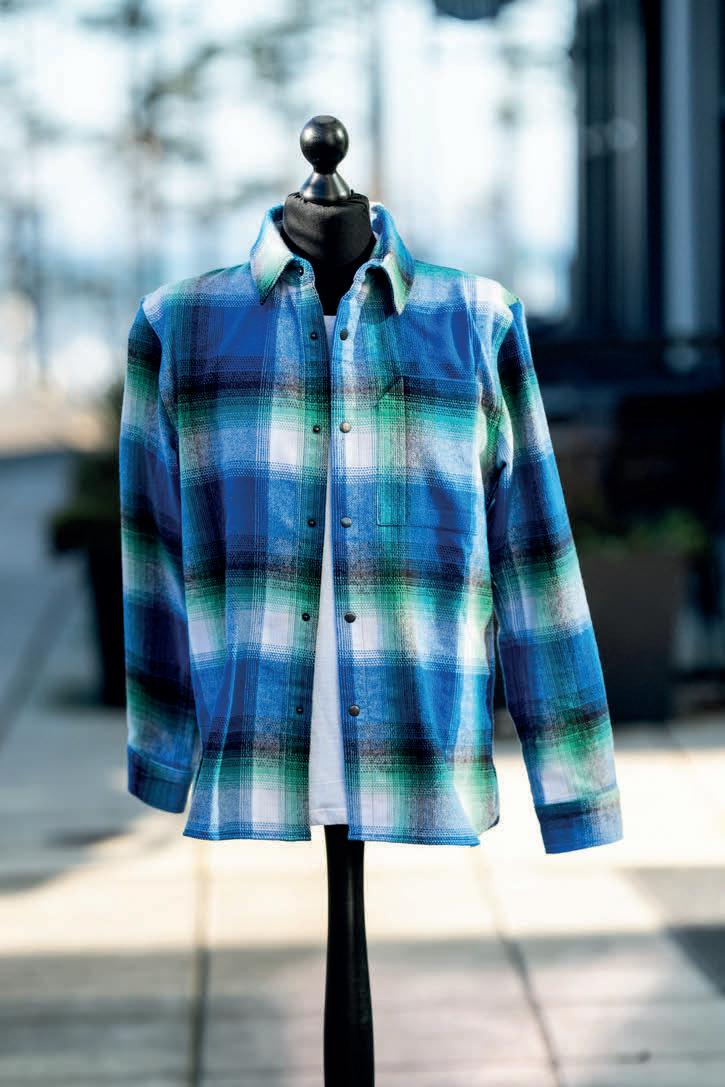







There’s so much to do here on any given day that such a robust calendar of events feels almost superfluous—but in reality, these seasonal activities serve to enforce the emphasis on community building and merrymaking that is a hallmark of the Seabrook way.

Reset after your holiday indulgence with a month-long series of wellness-focused activities like yoga, pilates, meditation, reiki, and nutrition, every Saturday this month. In addition, the third annual beachside author series starts now and features monthly events through June.
When other families head to the slopes for mid-winter break (Feb. 14-22), you should definitely head to the beach instead. Or if you have time to slip away as a twosome, don’t forget Valentine’s Day, Feb. 14.
Seabrook’s legendary biannual glass float find—in which locals follow clues to hunt for hidden glass floats throughout the town—kicks off March 23 through April 19, the same timeframe as SpringFest. In addition, the Shamrock 5- and 10-kilometer races are scheduled for March 14.

Warm weather brings an influx of planned activities, like the area’s biggest food festival Savor Seabrook (May 16), which features bites and sips from gourmet chefs and Washington wineries. Don’t forget to treat Mom to a Garden Party on the Promenade Mother’s Day weekend.
June through September is Seabrook’s busiest season— with the uptick in traffic comes an increase in weekly events, particularly those that take advantage of the weather: summer concerts on Fridays, yoga and farmers markets on Saturdays. Singular events like Seabrook’s Pride celebration (June 6), Father’s Day Fernwood Cookout (June 20), Porch Illumination Celebration (July 3), Founders Day (July 19), the Gnome and Fairy Festival (Sept. 12), and Bigfoot Brewfest (Sept. 26) round out the roster.
Fall ushers in an emphasis on keeping cozy, but there’s still plenty to do. Join the

Autumn Art Walk on Oct. 3, or the Fall Harvest Festival on Oct. 17. And bring out the kids and pups for Halloweekend (Oct. 23-24), with events like face painting, trick-ortreating, and more.
The second of Seabrook’s glass float events provides another opportunity to find treasure (Nov. 28-Dec. 31), and the Turkey Trot 3-kilometer run raises funds for the Seabrook Community Foundation on Thanksgiving (Nov. 26). Following Thanksgiving, it’s full steam ahead on Jolly Days, which kick off with a tree lighting (Nov. 27) and continue with holiday-themed weekends—ice skating at the new Fernwood Station rink, Santa visits, and real snow drops—culminating in a holiday parade.
Don’t Miss a Thing
s tay up to date by checking out Seabrook’s online calendar, as new events are added throughout the year! And if you’re interested in planning your own event, from elaborate weddings to intimate gatherings, please contact groupsales@seabrookwa.com.

To access the latest events, simply scan the QR code.



















































































These local retailers stock a little something for everyone
An extension of Spa Elizabeth, offering a lovely selection of gifts, skincare, beauty supplies, jewelry, clothing, and travel essentials for women and men.
Seabrook’s celebrated toy store (see page 24) offers an array of unique toys, games, puzzles, gifts, educational activities, and more.
An independent, family-run bookstore dedicated to providing a wide selection of books, games, puzzles, and quality novelty products.

Everyone’s favorite pet store carries both fun and practical stuff for dogs and their people.
This go-to shop for all things adventure (see page 38) offers guided day trips, topnotch bikes, gear rental, and beachwear.
A charming shop full of thoughtful objects for your home at the beach or to take back to the city.

Seabrook’s flagship retailer offers a wide range of branded clothing items for the entire family, along with high-quality hard goods and accessories.
A men’s clothing and accessories store providing a stylish selection of modern and classic goods.
Mr. Walrus
High-end home design, kitchen, and bath shop offering a unique assortment of handpicked, one-of-a-kind home goods and furnishings.
Lorraine’s
Blend your own custom scented candle at this welcoming studio, great for groups or a solo activity.
Shop a vast array of designer jewelry collections, unique accessories, and apparel at this global beach-inspired boutique.
This expertly curated collection of women’s clothing and accessories aims to offer something for everyone, whether looking for a stand-out piece or everyday comfort.

Find addresses, hours, and more information on local shops using the QR code.

marbles + games + puzzles + crafts + sand + more



Discover Seabrook’s flagship logowear store — a curated mix of resort brands, cozy layers, and quality accessories.

We asked local shop owners for their hottest items—here’s what they recommend.






GIFTS GALORE
1. Brooklets’ pressed penny collection notebook; 2. SeaWorthy Home’s vintage flannel; 3. NAHLA’s color-block cardigan; 4. Sol-ful’s pearl ring and brass cuff; 5. Seabrook Goods & Apparel’s signature heavyweight hoodie; 6. Lorraine’s Candle Studio’s bespoke candle; 7. PONDR’s throwback flannel.










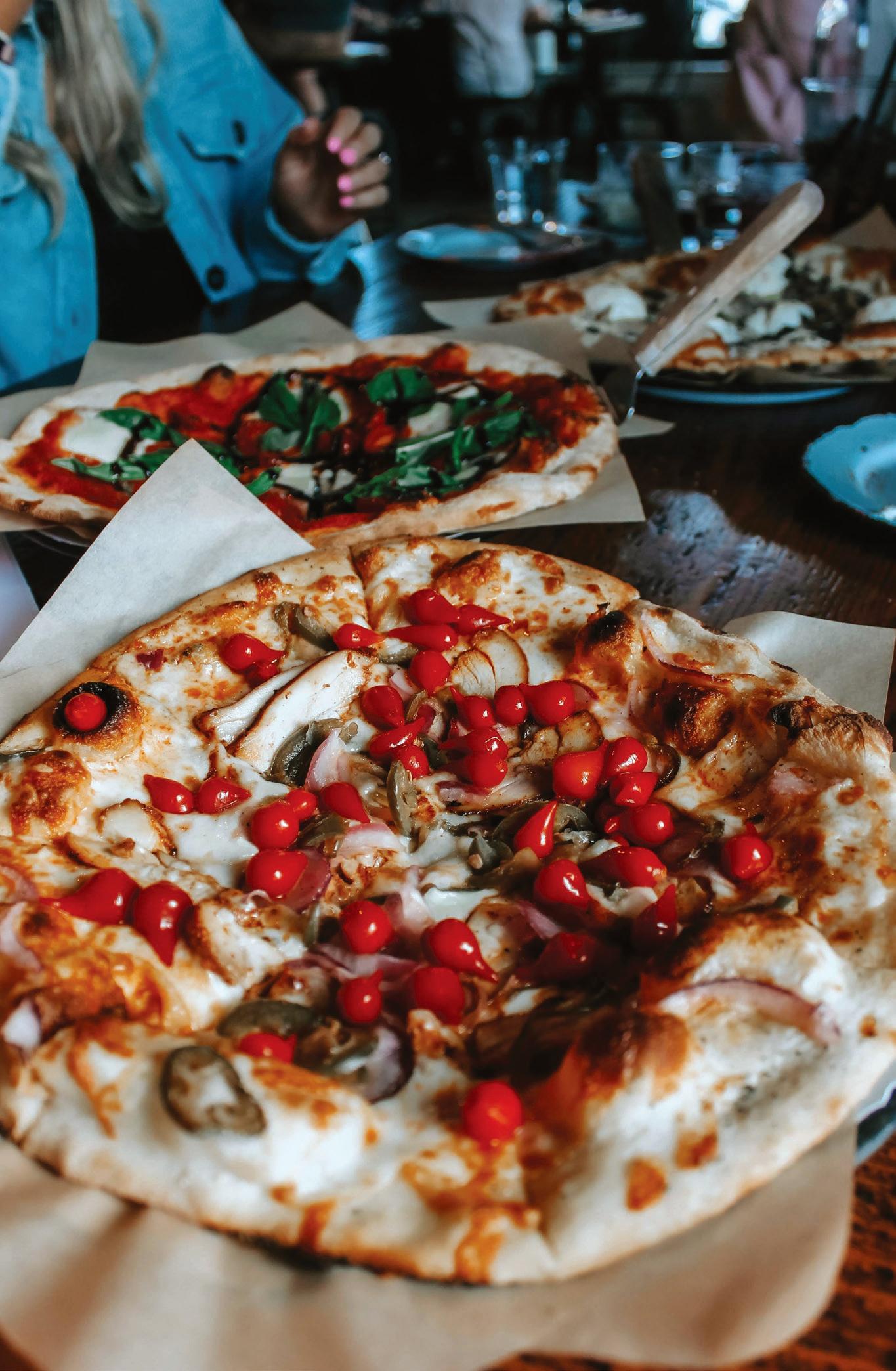
These local vendors make sure everyone’s well fed


MMM, MMM GOOD
Frontager’s Pizza Company (above) is known for their stellar pizzas and antipasti; Rising Tide (right) makes an excellent burger, cocktail, and so much more.
A full-service grocery store offering a massive selection of quality products at affordable prices—from meat and seafood to local produce, alcohol, snacks, and an impressive assortment of pre-made deli items.
The resident pizza shop and bar serves delicious brick-oven pies, alongside other Italian cuisine, wine, beer, and spirits.
A full-service restaurant with a cozy back bar, offering a menu of gourmet pub food like burgers, fish ‘n’ chips, chowder, plus more, as well as craft cocktails, beer, and wine.
A sweet shop stocked with multiple homemade ice cream flavors, plus chocolates, truffles, retro and imported candies, and all manner of sugary delights.
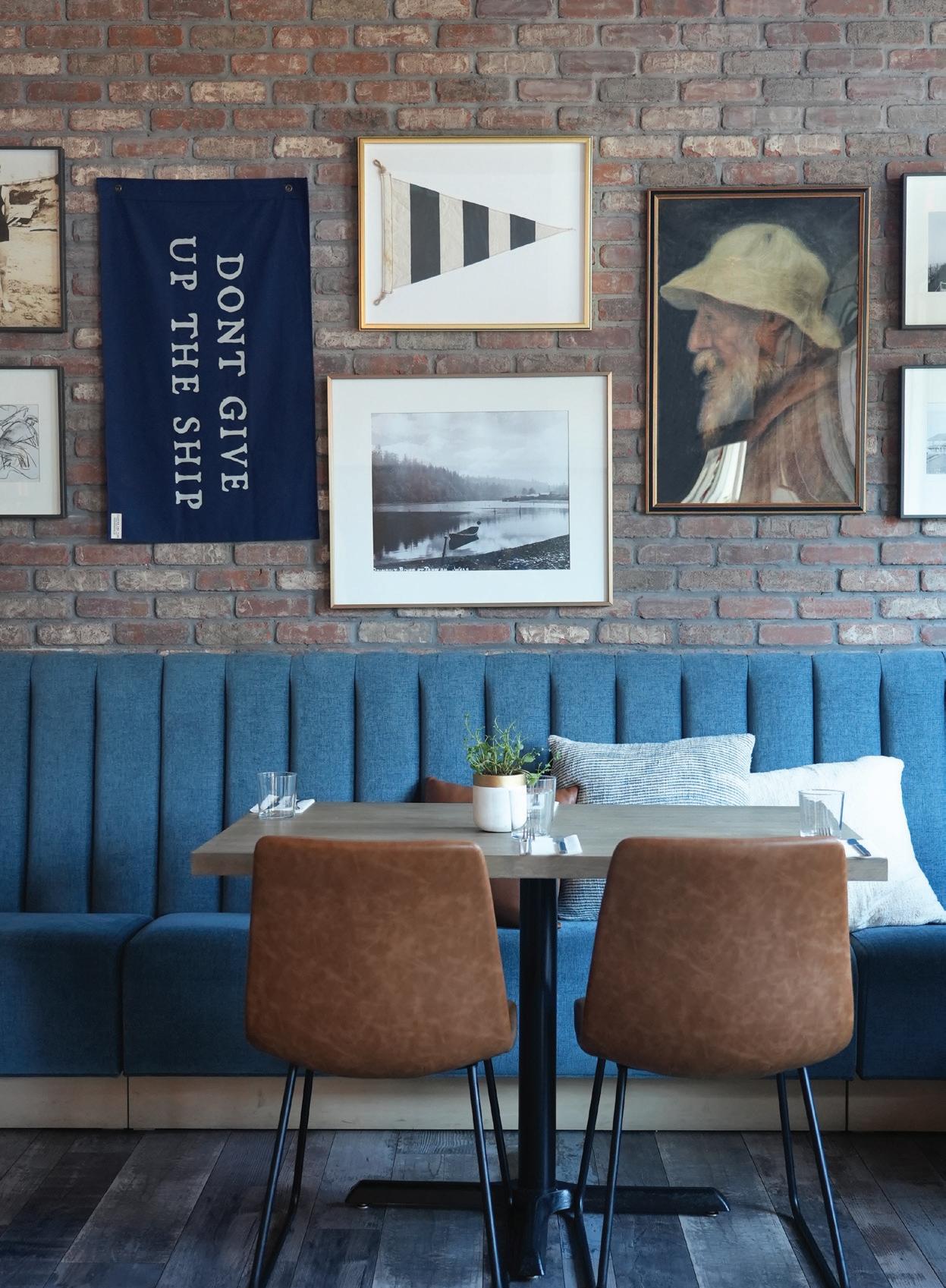


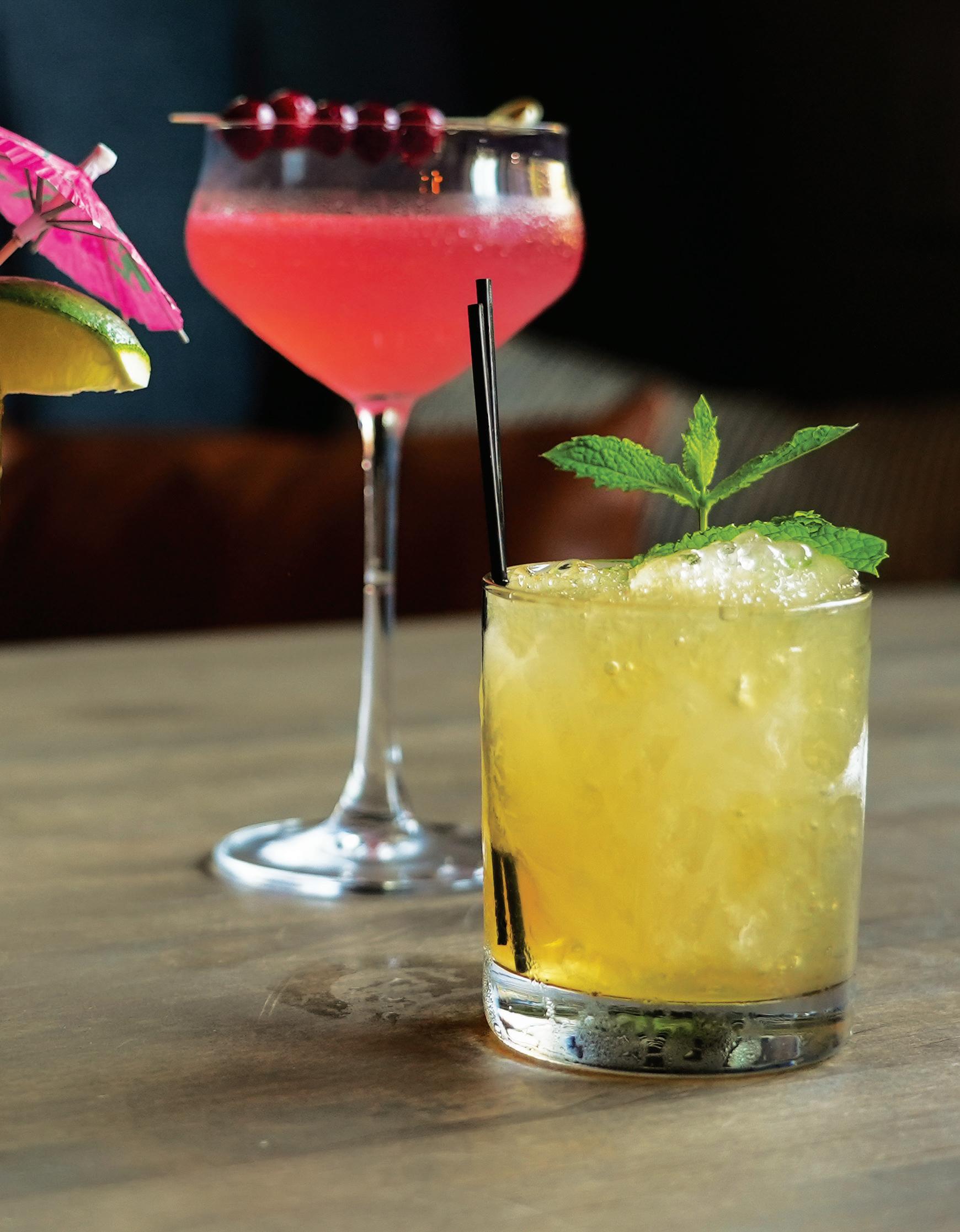
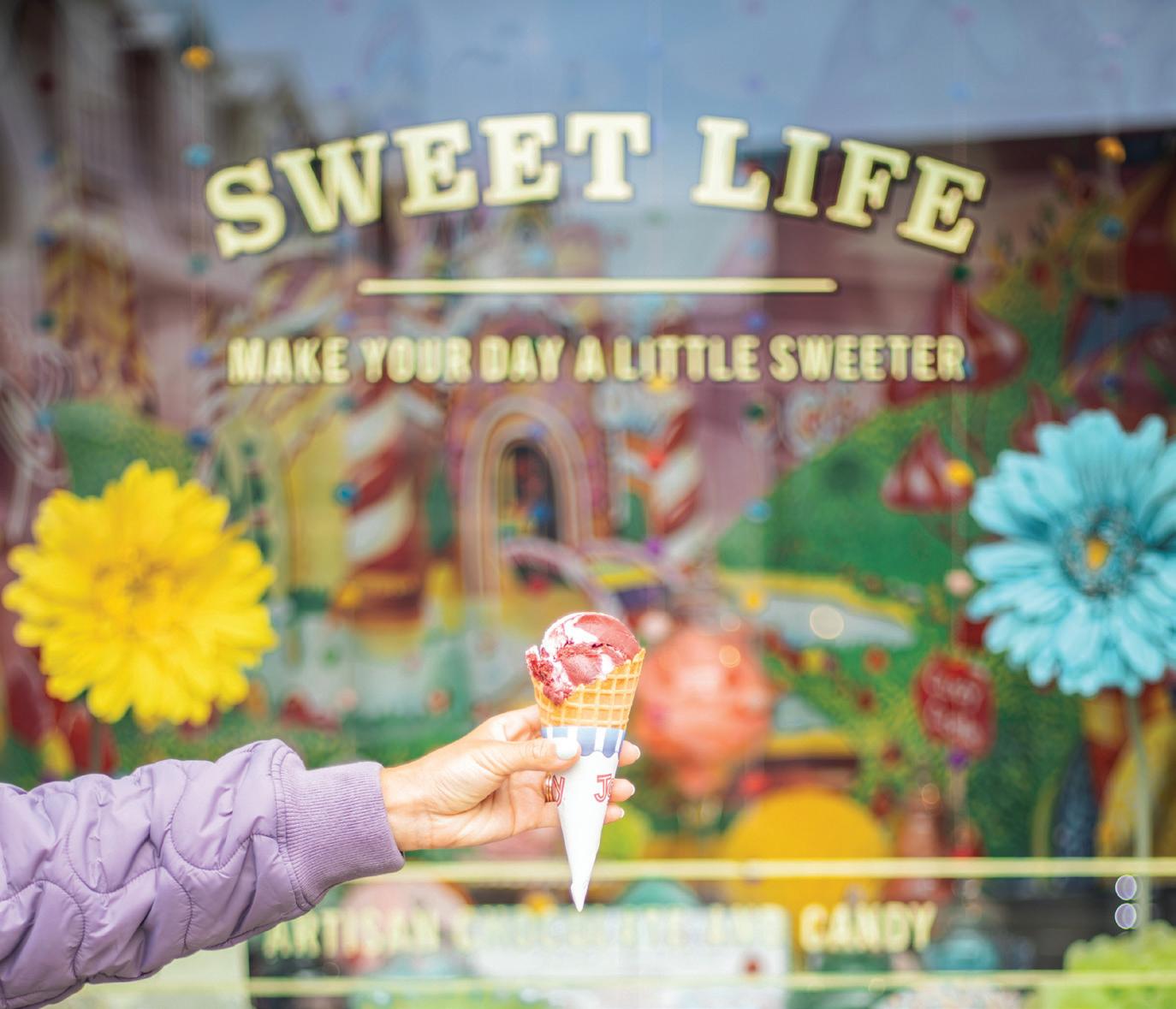

A corner restaurant overlooking the water (see page 20), with a food and beverage program inspired by Latin America, including the requisite margaritas and excellent tacos.
One of the best viewpoints in town offers wines by the glass, tastings, and flights, as well as beers on tap, alongside a menu of complementary food options, including charcuterie boards, salads, and sandwiches.
Everyone’s favorite coffee shop serves the best baked goods and fresh bread, perfect for breakfast or lunch, whether you eat in or take out.
This cafe offers a full coffee and tea menu and light fare ideal to grab and go.

ONE OF EVERYTHING
Have dessert first at Sweet Life (top); Koko’s enchiladas (bottom left) are always a favorite, but don’t sleep on the drinks, too.
(opening June 2026)
Schultz Farm (see page 30) is a regenerative farm in Seabrook specializing in organic produce. Their farmstand will be located in the Farm District and offer a daily harvest of seasonal veggies, run on a self-serve honor system.
Looking for holiday meals, full-service in-home catering, or simply snacks for when you arrive? Contact groupsales@ seabrookwa.com, and they’ll help meet your specific needs!

Find addresses, hours, and more information on local restaurants using the QR code.
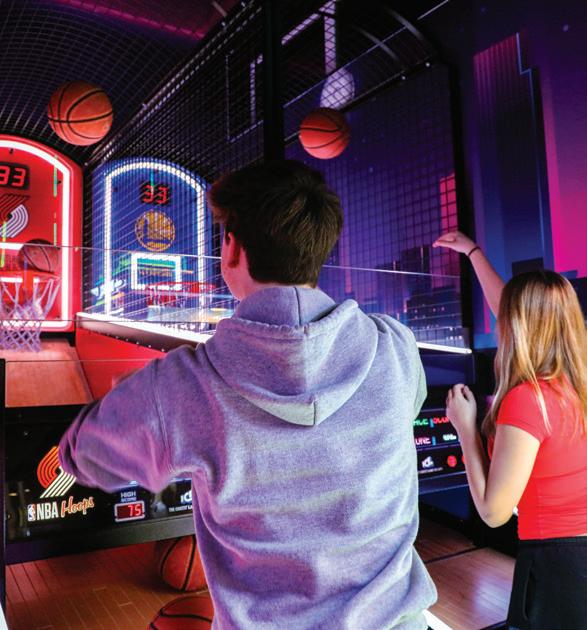
Seabrook Arcade
A delight for all ages, this retro arcade features newer games and claw machines alongside the classics like Ms. Pac-Man and Galaga, plus a prize counter to cash in your tickets.

Seabrook’s hub for wellness and serenity has been restoring and rejuvenating guests with a variety of spa services for 12 years—with big expansion plans for the future.



Richard Reith Owner/Financial Advisor PLR Wealth Management
Planning for the future can be confusing and overwhelming ... but it doesn’t have to be. Scan the QR code to schedule a time for us to discuss your financial situation or call me at (360) 948-6677
As founder of PLR Wealth Management, I bring nearly 20 years of investment experience to Pacific Beach. My goal is to offer clients the same guidance I’ve shared with my daughters: Perseverance is just as vital in good times as it is in challenging ones; Leadership is demonstrated even when no one is watching; and Responsibility means owning not only your actions but also those for which you are accountable.
I offer wealth management services to you, your family, or business, including:
• Customized investment plans
• Retirement planning
• Wealth planning
• Estate planning strategies
www.plrwm.com/contact.htm
• Tax-efficient investment planning
Make use of that gorgeous Seabrook home kitchen and all those razor clams foraged from the beach (page 41) in chef Becky Selengut’s favorite chowder recipe.
SERVES 4
2 tablespoons unsalted butter or extra-virgin olive oil
4 strips (about 3 ounces) bacon, cut into small dice
1 large leek, white and light-green parts only, halved lengthwise and cleaned, cut into small dice
2 ribs celery, cut into small dice,
¼ cup tender leaves reserved for garnish
2 bay leaves
1 tablespoon roughly chopped fresh thyme leaves
⅛ teaspoon cayenne
1 pound unpeeled Yukon Gold potatoes, cut into medium dice
¼ cup dry white vermouth
1 bottle clam juice (8-ounce)
1 cup water
1½ cups heavy cream or cashew cream
2 teaspoons fish sauce
¾ pound cleaned razor clam meat, cut into small dice
Buttery crackers (such as Ritz), broken up, for garnish Tabasco or other hot sauce


In a medium pot over medium heat, add the butter and bacon. Cook the bacon until its fat is rendered and it crisps up, 7 to 10 minutes.
Remove half of the bacon with a slotted spoon to a papertowel-lined plate and reserve for garnish; leave the rest in the pot.
Add the leek and cook for 3 minutes, or until tender.
Add the celery, bay leaves, thyme, and cayenne and cook for another minute.
Add the potatoes and increase the heat to medium-high. Cook the potatoes for 2 to 3 minutes, stirring occasionally. Add the vermouth to deglaze the pan, scraping up all the brown bits.
Add the clam juice and water to cover the potatoes.
Bring to a boil over high heat, then reduce to a simmer and cook the chowder uncovered until the potatoes are tender, 8 to 12 minutes more.
Add the cream and fish sauce and simmer for another 10 minutes.
Return the chowder to a boil over high heat, then turn off the heat (or remove the pot from the burner if you have an electric stove).
Add the razor clams, cover the pot, and let them poach for 2 minutes—do not overcook or they will become tough and rubbery.
Season the chowder to taste with more fish sauce or some salt. Garnish with the celery leaves, reserved bacon, and crackers.
Serve with Tabasco.
Courtesy of Sasquatch Books
becky selengut is a Seattle-based author and private chef, whose cooking classes, cookbooks, and YouTube videos aim to teach the curious home cook how to be better in the kitchen. She’s also an active forager, which is where this recipe (razor clam chowder from her book Good Fish) comes into play. Selengut’s latest book is called Misunderstood Vegetables; her next, Lettuce Riot, a book of salads, will be out in December 2026.





These locals share their Seabrook story—and how they’ve gone about building the community that makes this town feel like home.
Most people go to seabrook to relax not Gibran Moreno. When he’s in Seabrook, he’s all business, but he wouldn’t change a thing.
Moreno and his partner, Alexi Torres, own the incredibly popular Koko’s, a restaurant and tequila bar that found a following during the pandemic in a cozy space on the corner of Seabrook Avenue and Front Street. Over the years, their fan base has only grown—in 2026, they move into a splashy new location with perhaps the town’s best view, in the Pacific Landing building right on Hidden Coast Scenic Byway.
Torres grew up locally in Aberdeen, and when the two Seattle-area hospitality veterans were deciding where to open their first restaurant, he suggested they head to his hometown, where rents were cheaper and they could start small. That first business was the origin of much of the Koko’s menu, and where the two really dialed in the importance of customer service, trying to replicate a big-city hospitality experience in a much smaller town.
As it turns out, good food and good service does attract the right kind of people—Moreno says someone from Seabrook called one day and asked to talk with Torres about opening a location
there. He thought it was spam. Turns out, it was a legit offer, and the two opened Koko’s in early 2020.
That first year was hard for obvious reasons, but it cemented Moreno and Torres to the community. They buoyed the locals— donating 1000 burritos a week to the Pacific Beach Elementary School’s free-and-reduced-lunch program feeding kids during the early pandemic days—and in turn, the locals showed up and fell in love with their flavorful, inventive Latin American cuisine.
Now, Moreno and Torres have been so successful they’ve opened a second Koko’s location in Seattle’s Capitol Hill neighborhood. They split their time between the two spots—thankfully they have an amazing team at both that can operate independently—treating their car like a mobile office.
Do they find time for fun, in this destination built for it? Yes, Moreno says, though it’s hard to tell if it’s just that he loves what he does so much it doesn’t feel like work. “When you’re here and it’s high season especially, there’s just not a lot of time to hang out,” Moreno says. “But we have a great relationship with the other business owners, so occasionally we’ll go for a late meal at one of the local spots. Even though we own a restaurant, sometimes it’s nice to go to another restaurant and feel like a customer.”
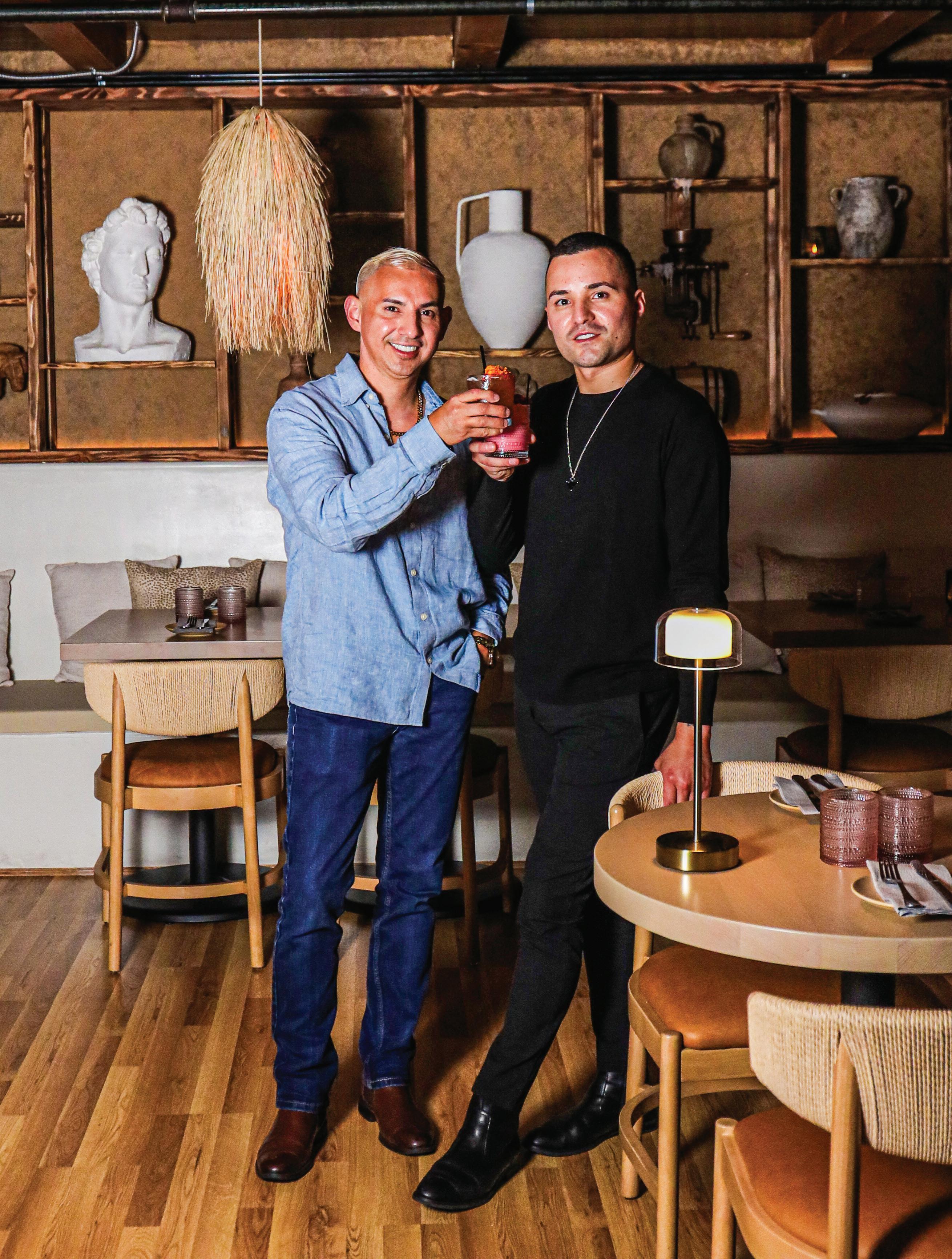
Amy o’brien has accomplished the impossible: making every day feel like vacation.
Born and raised in the Seattle area, O’Brien was living in Kirkland when the Covid pandemic hit in 2020. As a mortgage broker during that time of ultra-low rates, O’Brien was working around the clock. “All I did was work, eat, sleep, work, eat, sleep, for months,” she says. “I knew that I needed to get away.”
She’d visited Seabrook before and decided to spend a week working from there for a change of scenery. Not a vacation, necessarily, but better than working from home.
What transpired over that week in July 2020 changed her life dramatically. On a walk one day, daydreaming about which storybook house she liked best, she felt pulled toward a little green cottage with a picket fence and learned it was for sale. She hadn’t been looking for real estate there—hadn’t even considered it until then. But she went home and called the agent. She was writing an offer letter the next day.
That September, O’Brien moved in—not as a frequent visitor with a home

base elsewhere, but as a permanent, full-time resident. She maintains her bustling mortgage business, largely still working with Seattle and Eastside clients, from her cottage by the sea. And despite hours that can still be long, she says she’s easily able to leave it all behind when she walks out her front door: “It still has that vacation vibe even though I’m living here. There’s definitely something magical about it.”
One of O’Brien’s favorite things is the easy access to nature. “It’s perfect: I want to be able to see the ocean, hear the ocean, smell the ocean, walk by the ocean… and the woods,” she says. “It’s such a soulful, healthy place to live.”
But what’s made this place feel like home has been the community she became quickly and completely enveloped in. O’Brien helped found the Homeowners’ Activities Team— locally known as HAT—to coordinate monthly social and volunteer events to build community, things like karaoke night, private shopping events with local merchants, beach cleanups, game nights. Like many in Seabrook, she’s also an active pickleballer, and has found a robust community with that shared interest as well.
“The longer that I’ve been here, the more I love it.”
If you own property in Seabrook and would like to be involved in HAT, please email seabrookhat@gmail.com to be added to the mailing list.


As a kid, lindsi fry dreamed of sidewalks. She grew up on the stretch of highway called Aloha on Ocean Beach Road—“as local as you can get,” she says—and the rural life had many charms, but all she wanted was the kind of sitcom childhood where she could ride her bike around town with friends. It’s just perfect that now, as a grown up, she’s Seabrook’s resident magic-maker.

Fry manages Brooklets, the shop on Market Street so full of toys they actually spill out onto the sidewalk. There are stuffies—Jellycats, even—puzzles, art supplies, sand toys, nostalgic classics, marbles galore, and pretty much anything else you can think of to amaze the young and young at heart. Fry is responsible for all of it.
“I’m just kind of a kid at heart,” Fry says. “I love the whimsicalness of life. Kids are the best! I love seeing the world through their eyes and doing whatever I can to make life magical for them.”
Growing up so close to Seabrook, Fry has seen the town sprout and grow, from “nothing but trees” to the vibrant community it is today. Her parents are teachers, and she thought she may follow in their footsteps, but it didn’t take long for her to realize that maybe she was better suited for a profession that had more opportunity for childlike fun, endless creativity, and one-on-one interactions—she’s been a music teacher, a tutor, an educational assistant at Pacific Beach Elementary School, and a nanny.
In fact, she was first introduced to founders Casey and Laura Roloff when their daughters were in elementary school; she became their tutor, then nanny, then a veritable part of the family as a full-time assistant. She worked with Laura to learn the business of buying and merchandising Seabrook-branded apparel and goods, while also being tasked with many creative endeavors around Seabrook. Fry even earned the nickname “The Bedazzler,” as she was so frequently associated with decorating and holiday window displays. (Fun fact: She hand-painted the Sasquatch and other “face-in-the-hole” murals seen around town.)
When Seabrook’s first iteration of a toy store outgrew its home, Fry was tapped to take on the expansion, even coming up with the name. Nearly everything in the shop is meant to be interactive: Handwritten notes are thoughtfully placed around to instruct, recommend toys, or just to make people laugh, and the black-lit room and mini stage are fan favorites. Fry is still charmed every time she makes someone’s day. Fry says she’s an introvert at heart, who loves spending time in her cozy carriage house when she’s not at the shop. It’s hard to blame her, with a job that demands she be friendly and engaging all day. For Fry, though, that seems to come second nature. “I just really love it here,” she says, speaking of both the shop and Seabrook. “There’s nothing else I could ever see myself doing.”
Hardie® Artisan® siding brings a level of detail that elevates exteriors. Designed for striking architecture, built with lasting resilience from the #1 brand of siding in North America.*








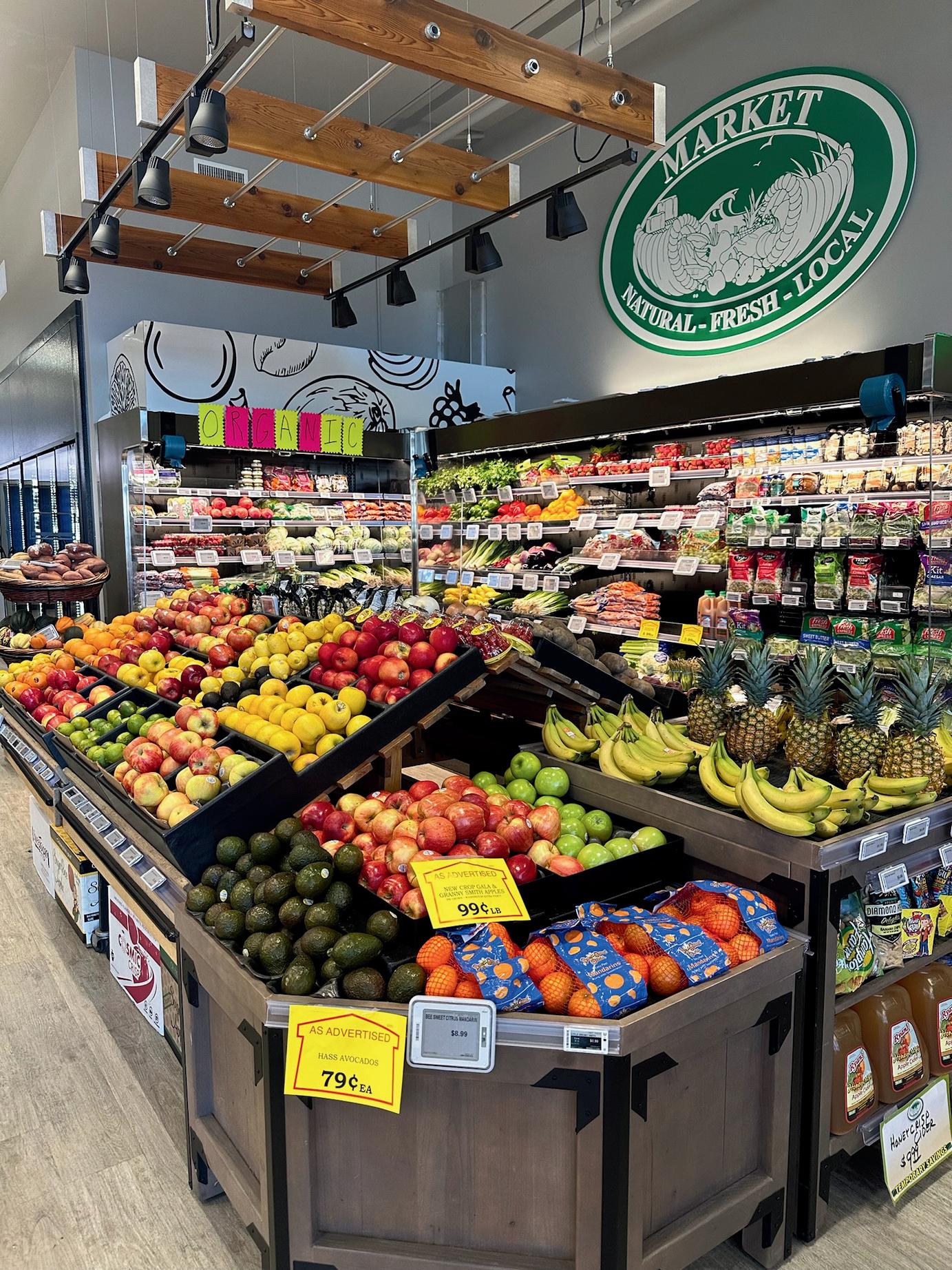




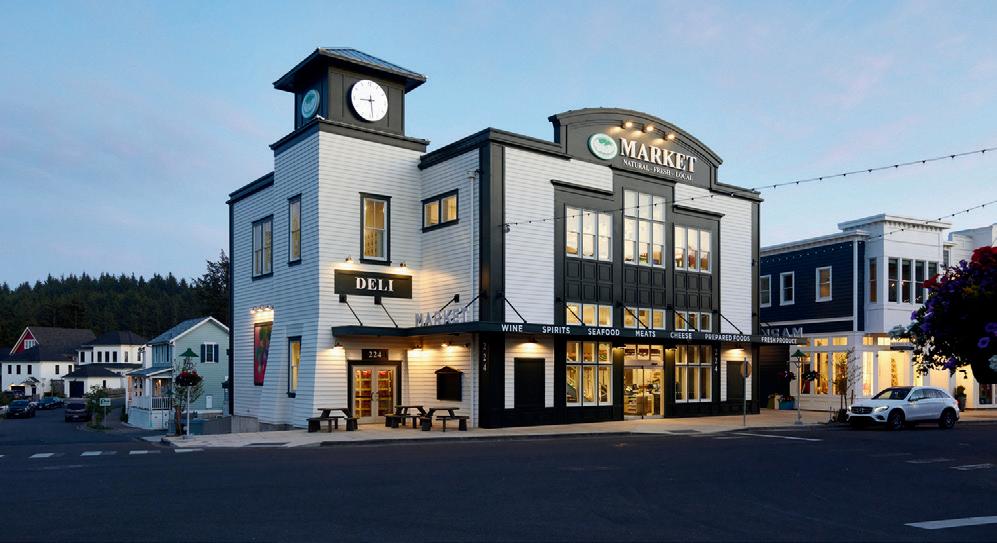







As Seabrook has grown, so too has the ability of the Seabrook Community Foundation to give back to the greater North Beach area. Now, the philanthropic group is working on its most ambitious projects to date: a rural health clinic and community center.
For many who fall in love with Seabrook, the town represents a vision of what’s possible—a community built on connection, natural beauty, and functional urban design. But that philosophy extends beyond the charming homes and amenities to an investment in stewarding the land and giving back to the broader North Beach community.
To focus those efforts on tangible results, the Seabrook Community Foundation is a nonprofit organization devoted to supporting local education, health, and cultural initiatives. Every time a Seabrook home is sold or resold, 1% of the sale price goes directly to the foundation, creating a sustainable financial commitment to the community—an enduring promise that growth here benefits the greater good.
Since its founding in 2007 by Casey and Laura Roloff, the Seabrook Commu-
nity Foundation has awarded $7 million in grants and scholarships across the North Beach “triangle,” from Taholah to Copalis Crossing. In the last year alone, the foundation awarded $115,000 in scholarships to local students, many overcoming tremendous challenges to pursue higher education.
Interim executive director Kennedy Gwin knows first-hand the importance of community support. Her family has
deep roots in Grays Harbor County—she grew up in Humptulips and graduated from Hoquiam High School, where her brother is currently a math teacher—and she’s ecstatic to be in a position where she can give back. “I am a testament to my community—I would not be where I am without them,” Gwin says. “I was given scholarships to go to school, I was given the opportunity to meet with people who I maybe wouldn’t have crossed paths with had it not been for my community.”
the foundation’s current priorities focus on long-term impact. Construction is underway on a Rural Health Clinic in Pacific Beach, in partnership with Harbor Regional Health. When completed, it will bring primary and specialty care to a region where the nearest hospital is more than a half hour away.
Alongside it, Gwin says they’re in the early planning stages of a community center to support families in the North Beach School District. The first step is soliciting local input to ensure the space truly serves the people who will use it. But the goal is to provide a “third place” for local families to access sports programs, socialize with peers, join community events, and more. Gwin says they’re working with the Seattle Sounders’ RAVE Foundation to build a soccer pitch nearby also. The hope is that the center can be built within walking distance of Pacific Beach Elementary; Washington state legislature has already allocated funds to rebuild/relocate that school, where many Seabrook families’ kids attend, to be safe in the event of a tsunami or earthquake.
“We are locally invested, and we have a lot of diverse voices coming together in our board—from Seabrook, Pacific Beach, Taholah, and beyond,” Gwin says. “There’s just so much beautiful potential here”
t he seabrook community foundation strives to create opportunities, foster equity, and build a stronger, more resilient future for all—but they can’t do that without the support of neighbors, homeowners and visitors who believe in giving back. To support scholarships, youth programs, and local health initiatives, or to learn more about volunteer opportunities and upcoming fundraisers, visit seabrookcf.org.

To donate, simply scan the QR.











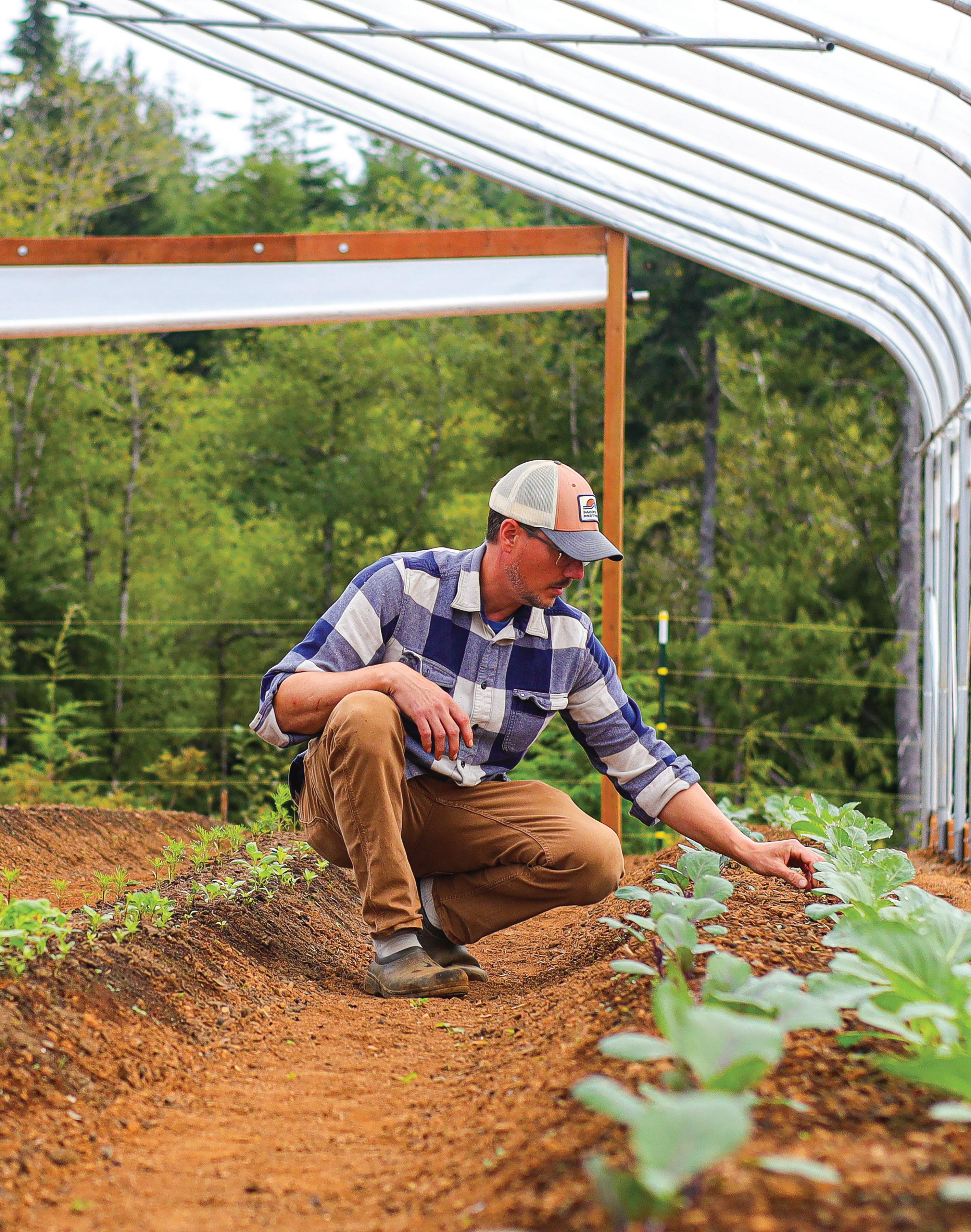

FIELD NOTES

Scott Schultz has turned a plot of unhealthy, clear-cut forest into Seabrook’s first regenerative farm— with big plans on the horizon.


It’s
You’re bumping along a dirt road, heading east from Seabrook’s Fernwood neighborhood, deep in the forest most commonly occupied by mountain bikers and mushroom foragers. The thick canopy of conifers blocks out the sun. So, when Schultz Farm finally comes into view—a patch of blue sky illuminating 3 acres of carefully tended earth in the middle of the wild—it feels like a mirage.
DOWN AND DIRTY
Converting forest floor to healthy soil is no small project, but Schultz (top right with Doberman Gus and below with the farm’s first potatoes) is up to the task.
The mage of this magical land is Scott Schultz, a flannel-wearing chef-turnedfarmer who has spent countless hours over the last two years converting a forest floor into a fertile garden space that recently welcomed its first crops. “He is the hardest worker I’ve ever seen,” says partner Mark Huck, who helps with the farm’s logistics but humbly admits the vision and manual labor are all Schultz. “What you see here is really the work that one very dedicated person can do.”
Schultz came to be Seabrook’s resident farmer after a chance encounter with
founder Casey Roloff while his band, Atari Ferrari, was playing the summer concert series a few years ago. Schultz was looking to escape Washington’s eastside, where wildfires had endangered his family and farm animals one too many times. Roloff had an 80-acre plot of land he was hoping to find someone to tend responsibly, taking what had been clear cut and mismanaged and returning it to a healthy part of the local ecosystem—one that would give back to locals in the form of sustainably grown food.
Daunting? Maybe. “But I’m a little bit crazy,” Schultz says, laughing. “I just love to stay busy. I thought I’d be overwhelmed the whole time, but I’m not, because I’m just being incremental about it.”
In that way, the farm is a microcosm of Seabrook’s philosophy to only build what you need. They started by picking the flattest spot, grinding stumps, picking rocks, bringing in a well and a solar pump, building hoop houses to extend the growing
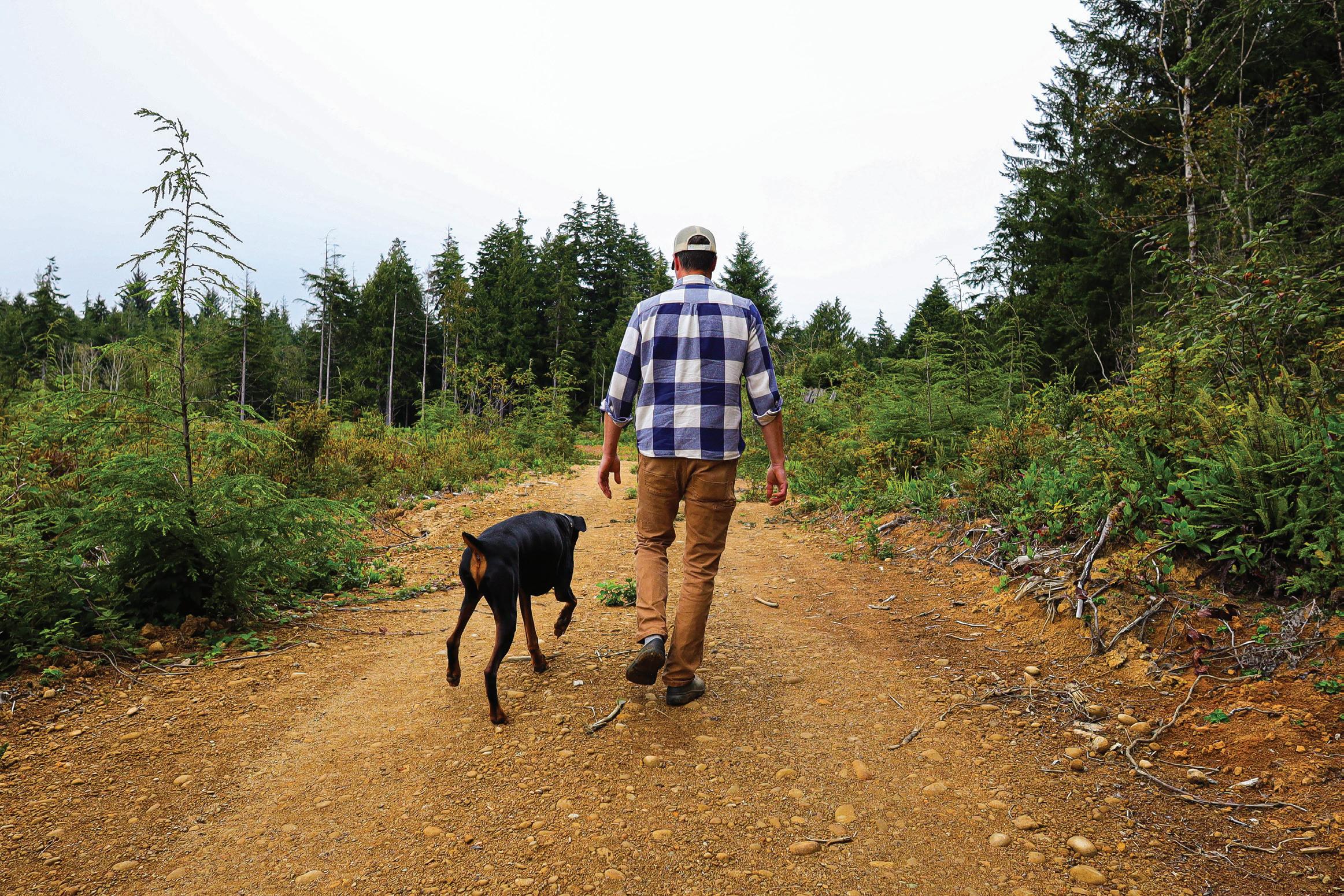
season. Schultz has been using two biochar kilns, which heat stumps, brush, and other organic waste to a temperature short of ash, resulting in a porous, carbon-rich material similar to charcoal that can be added back to the soil to make it healthier and better for long-term growing.
these first two years have been as educational as they have been physically exhausting: Schultz’s farming experience on the warmer, dryer side of the state hadn’t prepared him for the coast’s earth, salt spray, and microclimates. “We’re just learning as we go here—I’m doing my own MasterClass,” Schultz says, bending down to pluck one of the blackberry bramble shoots that seem to pop up overnight. “As a farmer, you have to be a mechanic, you have to be a plumber, you have to be an electrician, you have to be able to build. But the biggest thing is, you have to be able to nurture. You have to be able to take after things, whether that be animals, plants, your family.”
Perhaps the biggest early achievement is the launch of Seabrook’s composting pro-

gram, which allows guests, homeowners, and restaurants to contribute vegetative waste for the farm compost pile. Schultz says they plan to expand it in 2026, making it easier for restaurants to participate, and getting the word out more broadly (to participate, you have to bring your compost to a central drop-off spot near the garbage bins in the maintenance area).
This year, they’ll also launch a community supported agriculture (CSA) program, bringing boxes of farm-grown veggies to participating homeowners through the growing season, with a farm stand available for guests who would like to purchase food while visiting. Schultz wants to partner with chefs to grow what the restaurants want to serve—a full-circle moment
considering farm visits were his favorite part about working in kitchens.
Surveying the expanse of land, Schultz sees nothing but possibility: “I’m so excited to have people come back in two years—it’ll be much healthier.”
In the meantime, he couldn’t be happier to have made the move to the coast. He and his family have a 5-acre mini-farm of their own, complete with chickens and goats and “way too many dogs,” just off Highway 101. In the future, they plan to build a house on Seabrook’s farm property and add a barn for livestock. “We’re just surrounding ourselves with life. Moving over here has just been huge—the diversity, vegetation, the wildlife… this is exactly where I need to be.”
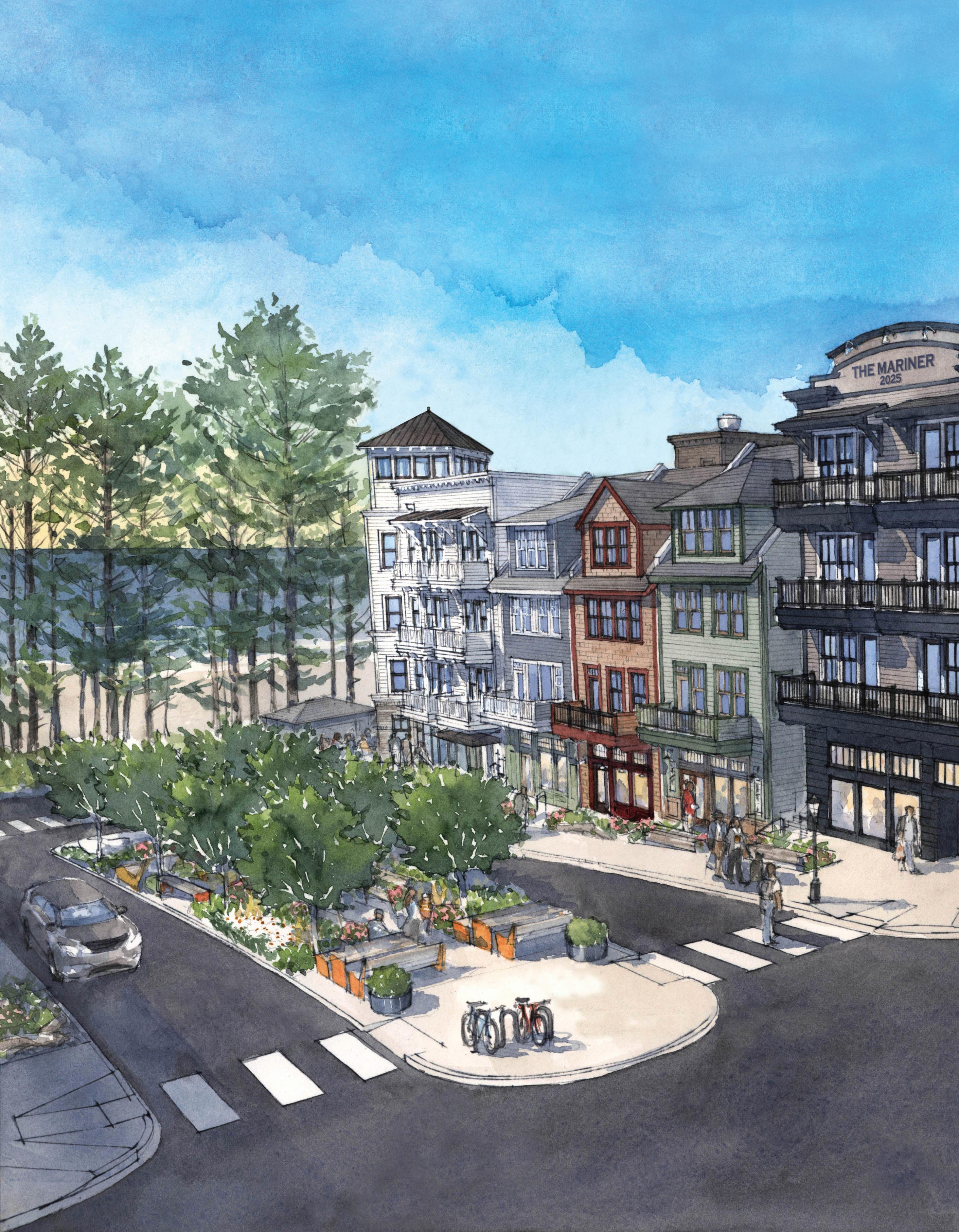
With construction bringing more retail and more residences to both ends of Seabrook’s magnetic downtown district, the big picture is finally coming into view.

WELCOME TO TOWN
Introducing the Sunset District, the block that will complete Seabrook’s town center.
Roughly 20 years ago, when Seabrook was little more than a chunk of land and an ambitious dream, Seabrook’s principal town planner Laurence Qamar sketched out a simple watercolor painting: a visionary street view with charming little buildings along one side, a few pedestrians, and beyond, the Pacific seen through wind-sculpted trees.
It’s a vista that now lives in countless social media posts and family albums. “It really is the iconic image of Seabrook,” Qamar says, “the connection of the main street we now call Market Street through a frame of preserved forest conifers, down to the beach, out to the ocean and the horizon and the sunset.”
It’s also the view that serves as the focal point of Seabrook’s final blocks of downtown buildings—over the next few years, the block bordered by Market Street, Front Street, the amphitheater, and the Hidden Coast Scenic Byway (SR 109) will be transformed into a mixed-use area called the Sunset District. The buildings will house some of the town’s most luxurious residences and effectively double the current number of restaurant and retail tenants. When completed, Sunset District will serve as an anchor to downtown and a beacon to drivers cruising up SR 109—ultimately completing a town center worthy of its legendary views.
folks who have been around awhile know that town founders Casey and Laura Roloff first set their sights on the Olympic Peninsula in the early 2000s after finding success with a similar venture called Bella Beach in Oregon. The couple were inspired by what they’d first seen in Seaside, Florida—a beach town built around the principles of new urbanism, prizing factors like walkability and neighborly connection over suburban sprawl. The result was a beautiful, environmentally conscious community beloved by locals and tourists alike—just the kind of thing Washington was ready for.
Fast forward more than two decades, and Seabrook is an established destination coming of age. Finishing the retail core has long been the plan, and now, the time is right. “In the new urban planning world, there’s a common notion of ‘rooftops be -


fore shops,’” Qamar says. “You have to have enough people living there, as well as visiting there, before you start investing in retail.” Without that, retail may inherently struggle.
Smart planning means the new construction is already primed to be a smashing success. Qamar planned the town center’s street and block network to encourage both drive-by access from passersby on the Hidden Coast Scenic Byway, as well as residents and guests who can easily walk and bike in from all of Seabrook’s outlying neighborhoods. The classic, timeless architecture is inspired by the leadership team’s favorite waterfront cities and towns, like Astoria, Port Townsend, Friday Harbor, San Francisco, Quebec City, and many more. The buildings are designed to
have individual yet distinct facades that include architectural elements like large bay windows, balconies, corner turrets, dormers, and spires to delight the eye and make the best functional use of space. “I’m unabashed in admitting that we look to history for our architectural inspiration,” Qamar says. “We’re all convinced that the way buildings were designed in the past shared more of a common language, while still having tremendous variety, creativity, and artistry to them.”
Stephen Poulakos, vice president of town planning, says that though the town center’s townhomes, condominiums, and other mixed-use buildings are designed to honor the architectural precedents of the past, they offer a level of modern luxury people have come to expect from Seabrook:
rooftop decks, covered front porches, large bay windows, convenient elevators, and well-appointed primary suites, all within a short walk to restaurants, shops, and the beach. And despite being four stories—the tallest in Seabrook so far—these Sunset District buildings have been intentionally crafted to capture ocean views.
It’s too early to call out what kind of retail or food vendors to expect, but fans of the arcade can get excited about an expanded version in the plans—multiple floors, possibly including escape rooms, and definitely with more games to enjoy.
poulakos walks us proverbially down Market Street to talk about what’s going on at the other end, across from the Town Hall: a nine-bedroom, New England-style residence intended for large group events “from weddings to family reunions to corporate retreats,” Poulakos says. The Newhart Building, as it’s been affectionately dubbed after the inn in the ‘70s sitcom Newhart, will feature a corner turret, walk-out balconies, and a large private courtyard for large group entertaining.
All this newness is very exciting, but co-founder Roloff actually says he’s looking forward to the future, when Seabrook gains that richness in depth that comes with age. “I know we just had our 20th anniversary,” Roloff says, “but I just keep thinking about how much more powerful it will be to be done [downtown], so it can start to patina. People always say, ‘Oh, Seabrook is so perfect, it’s so fake.’ And people aren’t going to be saying that in another 25 years. It’ll feel grounded, mature, and even more beautiful.”
There are plenty more exciting things in the works: a local health clinic (page 28), indoor pickleball facility, luxury hotel and spa, assisted living facility, more hiking and biking trails, a (small) golf course. Spend 15 minutes with Roloff and you’ll see there’s no shortage of ideas. The sky, or perhaps the sea, is the limit.
“All we’re trying to do here is build a place that makes you feel good,” Roloff says. “That’s really what the art of town building is about—entertaining the pedestrian and creating an experience that is memorable and a place you want to come back to again and again, or never leave.” Mission accomplished.
Consider this a cheat sheet to Seabrook’s look and feel
WALKABILITY
Streets are designed for pedestrians and bicyclists over cars, and most needs can be met within a safe, convenient, and enjoyable 5- to 10-minute walk or ride.
CONNECTIVITY
An interconnected network of streets, greenways, and pathways disperses traffic and encourages walking, while forested natural corridors act as connectors between neighborhoods.
DIVERSITY IN BUILDINGS
Neighborhoods offer a mix of retail and living spaces, as well as a wide variety of home sizes and types to create a welcoming environment for all people.
QUALITY ARCHITECTURE AND URBAN DESIGN
Beauty and comfort standards help buildings create a coherent sense of place; public spaces like streets, parks, and plazas are attractive as well as functional.
TRADITIONAL NEIGHBORHOOD STRUCTURE
Neighborhoods have defined centers and edges, with public spaces like
parks near the center, all designed to prioritize the rule of keeping amenities within a 10-minute walk.
INCREASED DENSITY
Near the town center and each of the outlying neighborhoods, residences and retail are close together for convenience and social engagement; transects radiate out from the centers of each neighborhood in progressively less density, to transition from urban to more rural spaces.
SMART TRANSPORTATION
Because driving is kept to a minimum, other forms of travel like cycling and walking are encouraged, and public transit is offered for those who need it for accessibility.
SUSTAINABILITY
Construction adheres to eco-friendly philosophies and building practices, and the community is designed to both integrate with and care for the natural surroundings.
QUALITY OF LIFE
These principles are in place to offer an enriching, inspiring way of life, where people feel connected to their community, neighbors, and environment.
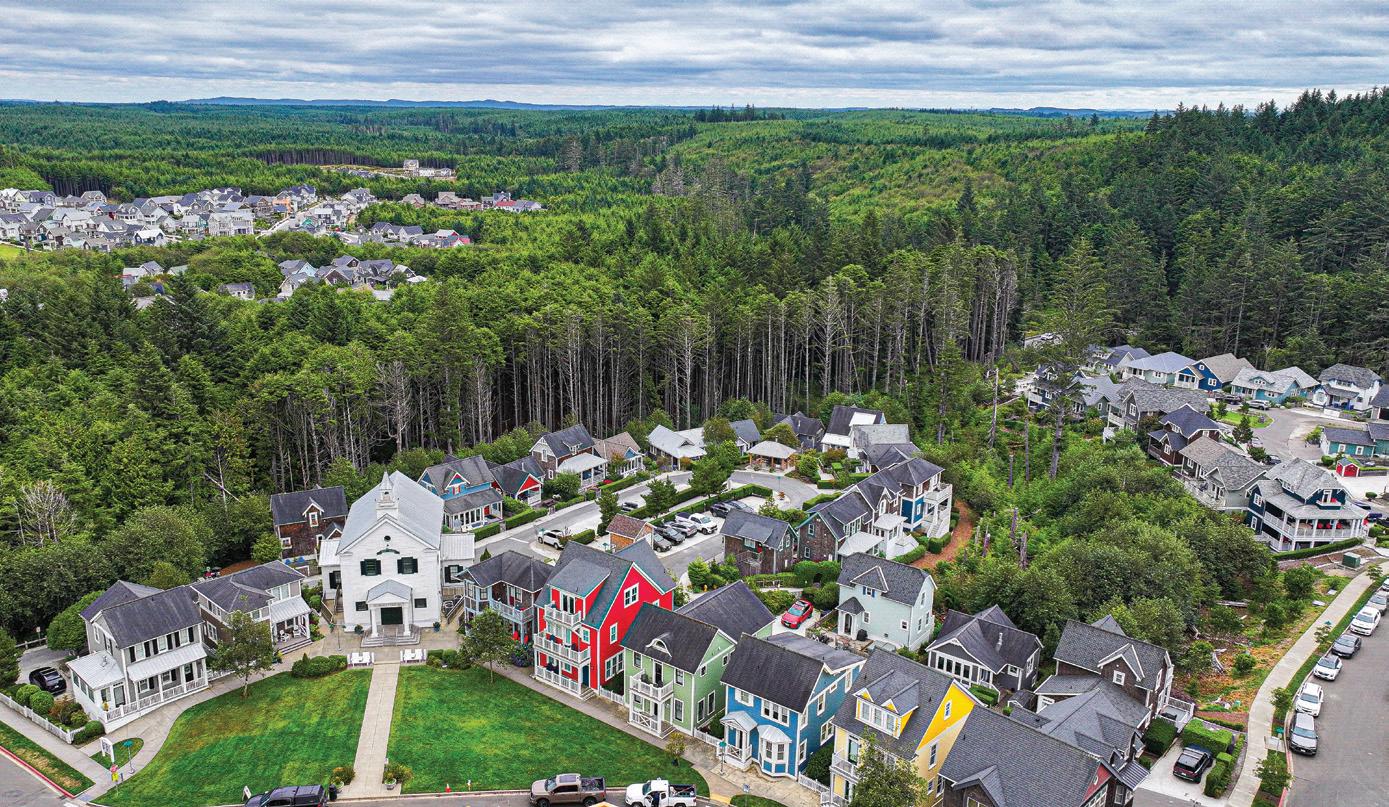


On water, in the woods, and around town, there are so many ways to explore the area with Seabrook as your home base.
Wwe get it —one of Seabrook’s defining qualities is that everything you need is really right here. But sometimes, adventure calls. And who are we to ignore an opportunity to explore?
The town’s position on Washington’s picturesque coastline provides the ideal launch point for daytrips near and further afield, whether you want to forage for dinner ingredients, explore the Olympic National Park, or simply while away the hours in a change of scenery. Let’s go!
b efore any adventure, you need the appropriate gear and a game plan— Basecamp owners Tiara Thurston and Jake Zvonar can hook you up with both.
Thurston grew up riding beach cruisers near her grandparents’ places in Ocean Shores and Copalis Beach. Years later, after a cross-country career in hospitality and luxury retail, she found herself back here where the forest meets the sea—only this time, with a husband, two kids, and a dream to help others experience the same magic.
In 2023, Thurston and Zvonar opened Basecamp, an evolution of Buck’s Northwest, Seabrook’s original gear-rental outlet. Their goal is to equip the average Seabrook guest or resident with everything they need to get out and explore—whether that’s the necessary equipment or guides or just some user-friendly directions.
Parents of wee ones will want to take particular note of the Seedling Adventures and seasonal kid camps—find out more at pacificedgeadventures.com.

(Duration: Half to full day)
for experienced and aspiring anglers, fall and winter on the coast bring terrific steelhead fishing, and Seabrook is just a short drive from popular river fishing sites. Steelhead enter rivers from September through November, with peak catch rates often in early November, when water temperatures drop below 50°F. The season varies based on the river but can last through March.
Wynoochee River – About 1 hour from Seabrook.
Satsop River – Also around 1 hour away, offering solid runs during the season.
Humptulips River – Accessible just 15 minutes away, and known for winter steelhead, but open December to March, with upstream sections closing by early January.
Hoh River – A bit farther at roughly a 2-hour drive, but a classic steelhead stream on the Olympic Peninsula.
New to fishing or need gear/license? Experiences can be arranged through Basecamp.

(Duration: Just a few hours)
Harvesting razor clams from the nearby shores is a Seabrook bucket list requirement—if you manage to claim your limit (15 clams per day), you’ve got a feast; if you don’t, you’ve had an upper-body workout and hopefully a few laughs. Clamming dates and times (season runs approximately October through May) are set by the Washington Department of Fish & Wildlife. The best way to pluck the oblong clams from their sandy homes is with a tube-shaped “clam gun,” which you’ll insert at an angle when you see the tell-tale spurt of water through the sand.
Pacific Beach State Park – A great entry-level spot with easy access. Copalis Beach and Mocrocks (which fronts Seabrook) – Popular and family-friendly spots for razor clams. Ocean Shores – Wide beaches, good for pairing with a day in town.
Reach out to Basecamp to rent clamming gear and get a license, and check the WDFW website (wdfw.wa.gov/fishing/ shellfishing-regulations/razor-clams) for
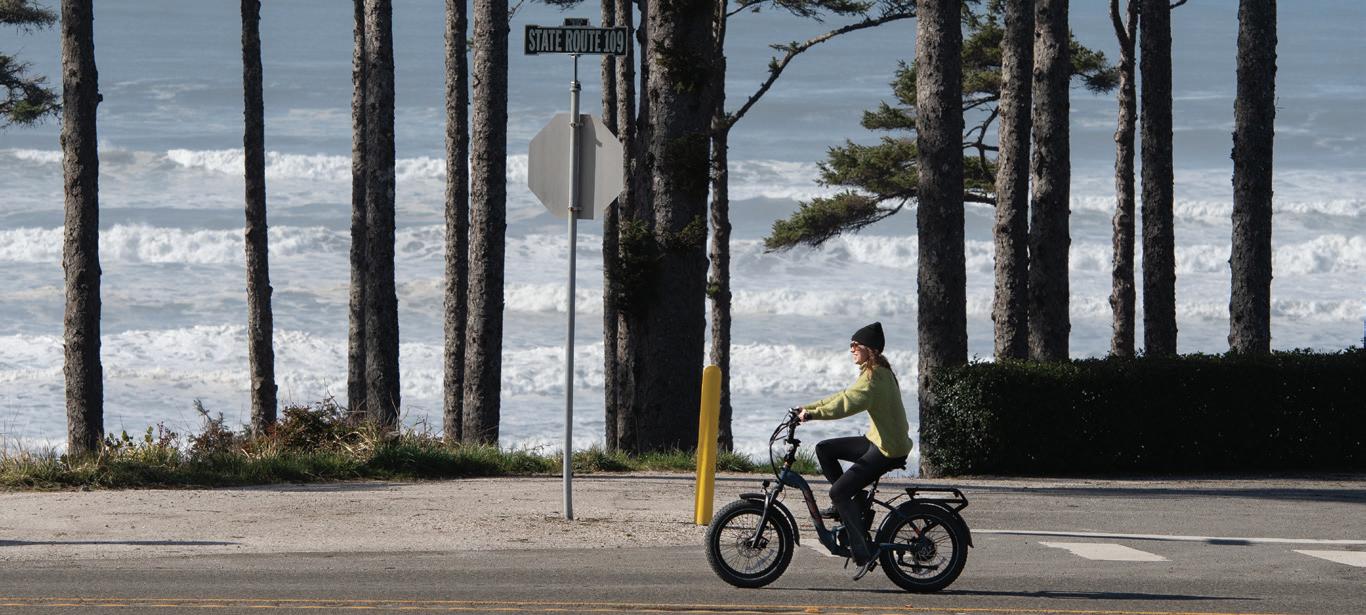
as a bike-first, pedestrian-friendly community, we’re all about exploring on two wheels. For guests visiting without bikes of their own, Basecamp can hook you up with a rental, but here’s what you

open clamming dates and times. Make sure you have a headlamp—many digs happen while it’s dark out!
Chanterelles and hedgehogs and oyster mushrooms, oh my! Seabrook partners with Michael Abramson, who owns commercial foraging business Wild Spores & More, on regular guided foraging tours throughout the fall within walking distance of the Farm District. You’ll need to buy a ticket in advance, but it’s well worth the price—Abramson shows you where to hunt and what to look for when you’re picking (many wild mushrooms have sneaky doppelgangers that can make you sick), and at the end, adds to your haul with a variety of foraged ‘shrooms from his commercial picking.
Stop by Seabrook Guest Services or call 877.779.9990 to book your expedition.
need to know before saddling up: Casual riders and families with young kids learning to ride will want to stick with cruisers like the Classic Electra Trek Pedal Cruiser, perfect for leisurely loops around Market Street and Compass Park. For the littlest riders, Basecamp also has balance bikes, training wheels, and trailers (the Fernwood neighborhood offers a quiet place to practice riding).
To explore Seabrook’s extensive trail network (page 50), more experienced bikers will want a hybrid bike or mountain bike, like the Hardtail Mountain Bikes Trek 6, 7, 8 (particularly for the off-road, single-track trails just behind Seabrook).
For beach rides, adventure-seekers should try the Trek Farley Fat Tire bike. Copalis Rock is a popular destination from Seabrook, best at low tide when the sand is packed. Fat tire bikes are a great crossover option if you’re interested in exploring the beach and the woods.
Remember, safety first: Basecamp will match you to a bike to suit your needs, and also make sure you’re equipped with the necessary helmets and accessories to make sure your adventure doesn’t end with an accident.


(Duration: Full day)

this is an excursion you’ll want to budget time for—but one not to be missed, particularly if you’ve never visited the Olympic Peninsula. Olympic National Park covers 1,400 square miles of spectacular wilderness, from the verdant beauty of the Hoh Rain Forest (2.5 hours from Seabrook) to the sea stacks and tide pools at Ruby Beach (1.5 hours from Seabrook).
You could spend a week exploring the breathtaking scenery, but that would take you away for too long from your cozy Seabrook cottage, so we recommend instead spending a day focused on visiting the Lake Quinault area (45 minutes from Seabrook). There, you can paddle across the lake’s glassy surface, marvel at the world’s largest sitka spruce, and have lunch at the 1920s lodge overlooking the lake (reservations for Lake Quinault Lodge’s Roosevelt Dining Room can be made by calling 360.288.2900). If weather impedes your plans, stay in the car and meander the Quinault Rain Forest Loop Drive (allow at least two hours), past waterfalls, the Quinault River, trailheads, wildlife, and plenty of places to pop out for a photo opp.
Paddleboards can be rented from Basecamp in advance; if you don’t have the roof racks to haul them there, you can also rent from vendors at Lake Quinault.
not every day is for adventuring, and when weather—or just the need for some downtime—calls for a change of pace, there’s no better place to be than on a couch, in front of a fire, with the perfect book. We asked Kristen Ardourel, manager of Seabrook’s charming independently owned bookstore Joie des Livres, for her recommendations for thematic Seabrook reads:
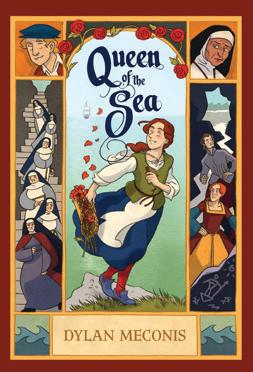
by Dylan
Meconis
Ardourel says Meconis grew up vacationing in Moclips and was inspired by the wild Washington coast when writing this piece of historical fiction loosely based on the life of Elizabeth I.

TO CATCH A THIEF by Martha Brockenbrough
The author, a longtime Seabrook fan, based this page-turning middle-grade mystery’s fictional town of Urchin Beach on Seabrook.

IT HAPPENED ONE SUMMER by Tessa Bailey
The first in a popular duo of spicy books, this story features influencer Piper Bellinger, who gets cut off from her family and sent to beachy Westport to teach her a lesson.
by
Steve Olson

S eattle-based Olson writes about Washington’s history—this book tells the tale of the Hanford nuclear facility, which visitors will easily recognize from the drive west from Olympia to the coast.
More local-ish authors Ardourel recommends: Kristin Hannah, Greg Olson, and Julia Quinn.
seabrookwa.com




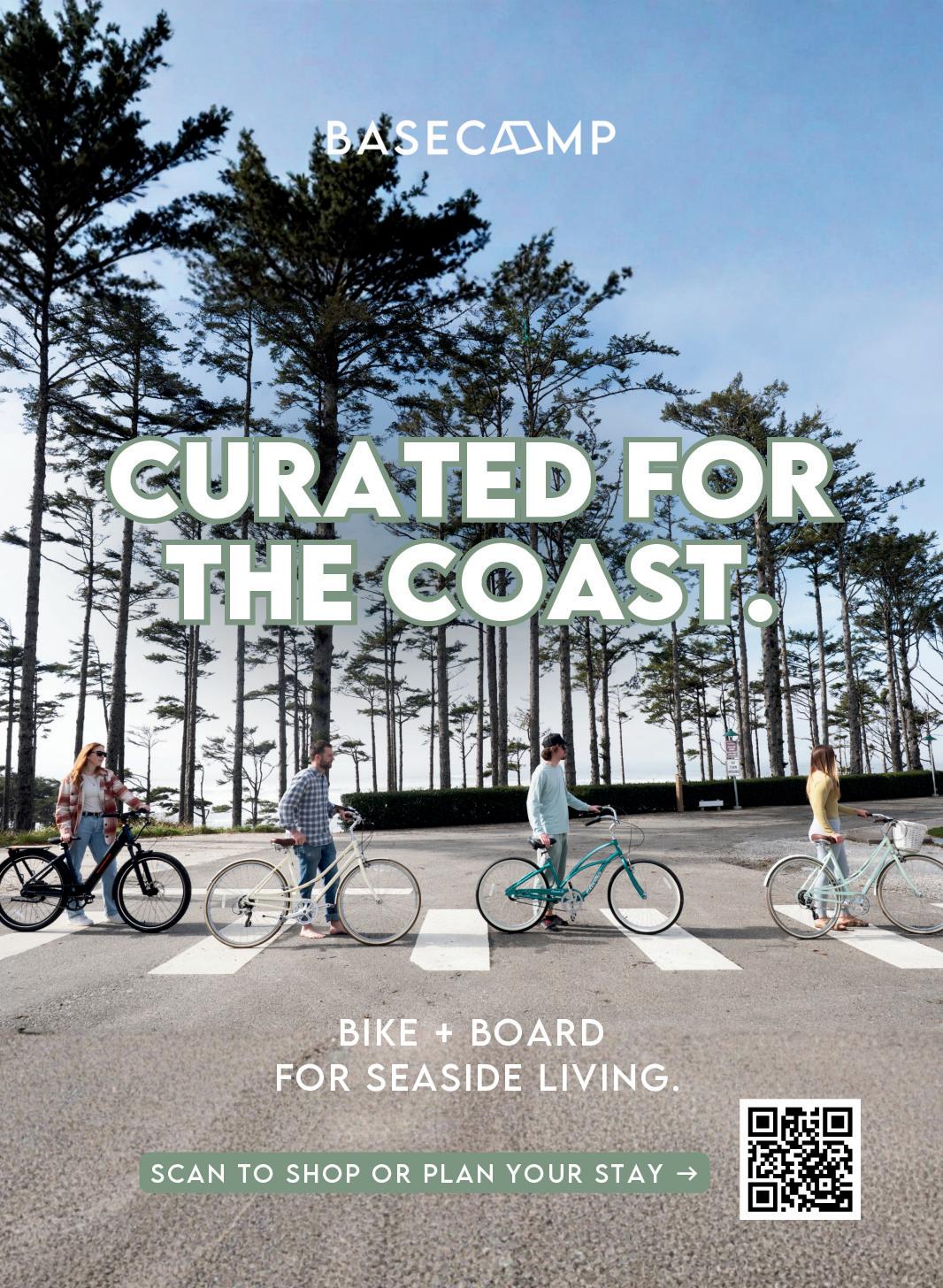
A Chicago couple plans their dream destination wedding in the place where they fell in love
When emma mitchiner and evan taylor met in 2017 as marketing interns at an Illinois corporate headquarters, they had their whole futures ahead of them. They just didn’t know then that those futures would be so intimately connected. Now business consultants based in Chicago, the two tied the knot August 23, 2025, in Seabrook’s Crescent Park in front of 170 of their closest friends and family, who joined them from around the country to celebrate a love that sparked in the midwest, but blossomed years later right here at Seabrook.
Initially just friends, Emma and Evan reconnected when the two reunited with their fellow interns in Chicago after graduation in 2019. They were still in the early stages of their relationship when the Covid pandemic shut everything down, but it was an easy decision to spend that quarantined time together.
“We were both working so much, we never would have gotten so much concentrated time together if Covid hadn’t happened so early in our relationship,” Emma says. “We were working from home together, we were in the same bubble, things just moved a lot quicker than they would have otherwise.”
In those days when airports were still ghost towns, the couple flew to Seattle to spend time in Evan’s family’s Seabrook cottage. Evan had grown up spending summers and long weekends in Seabrook—a short drive from his family’s Olympia home. He’d even interned at Seabrook and worked at Frontager’s Pizza Co. the summer before he’d met Emma. But this was a new experience, sharing the family house with a new love.


Emma says they spent two quiet weeks together, walking on the beach and enjoying one another’s company. It was her first time experiencing Seabrook, but wouldn’t be the last—over the next few years, the couple returned again and again, together and with their respective families. “It became a really special place to us,” Emma says.
So, after a Palm Springs proposal in 2024, the two couldn’t bear the thought of getting married anywhere but Seabrook.
“We love to be out there, and we’d always said, ‘Oh, Seabrook would be such an amazing place to get married, but it would be so hard to get to for our friends and family,’” Emma says. “But we just couldn’t imagine anywhere else—we did not even look at another venue. So, we just thought, ‘This is going to be a challenge, but let’s figure it out.’”
all the pieces fell miraculously in place. Family and friends booked their homes, made easier by the fact that Seabrook allows wedding guests to book before opening reservations to the






general public. Shuttles and carpools were coordinated from the airport. And Emma and Evan had their dream weekend surrounded by loved ones, with not a drop of rain in sight.
For the ceremony, Evan’s aunt spent months collecting driftwood to create a bespoke arch the couple was married under. “It was one of the most special parts of the day,” Emma says, “because she’d created this special element of the day that held so much significance.” Seabrook inspiration found its way into other elements of the planning and ceremony, from the blues and greens in the décor, to the oyster bar at the reception—a surprising hit with the Midwesterners, Emma says.
From the Taylors’ home in Chicago, Emma says a piece of their hearts will always belong in Seabrook: “We just always have a craving for it.” Thankfully, they have a family home to return to for generations.

Since 1966, we’ve helped thousands of families and businesses recover from the worst—floods, fires, and full-scale natural disasters. With decades of experience, 24/7 emergency response, and a commitment to guiding you every step of the way, we bring clarity to chaos and strength to uncertainty.
You can’t plan for everything—but you can plan to have the right team by your side.


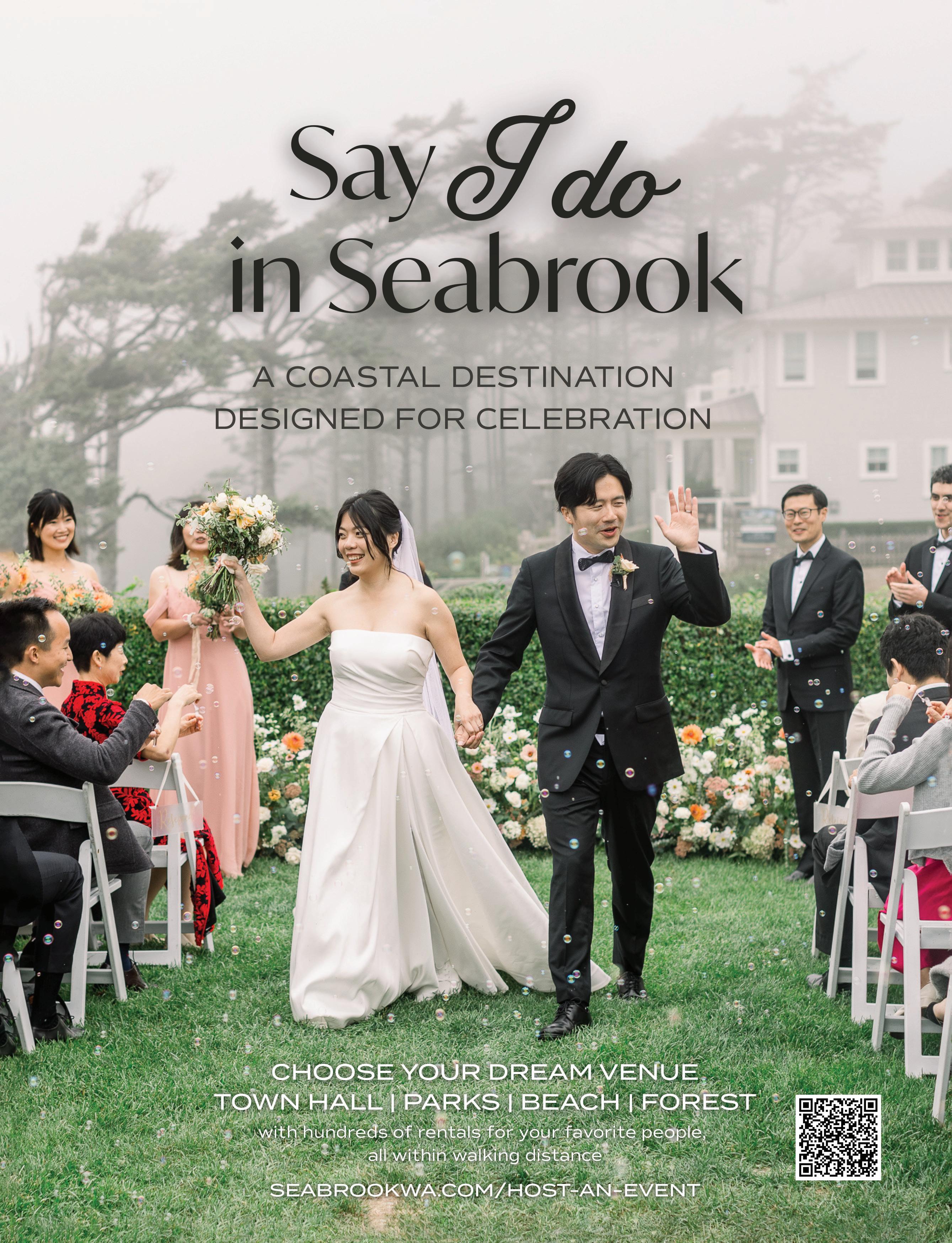








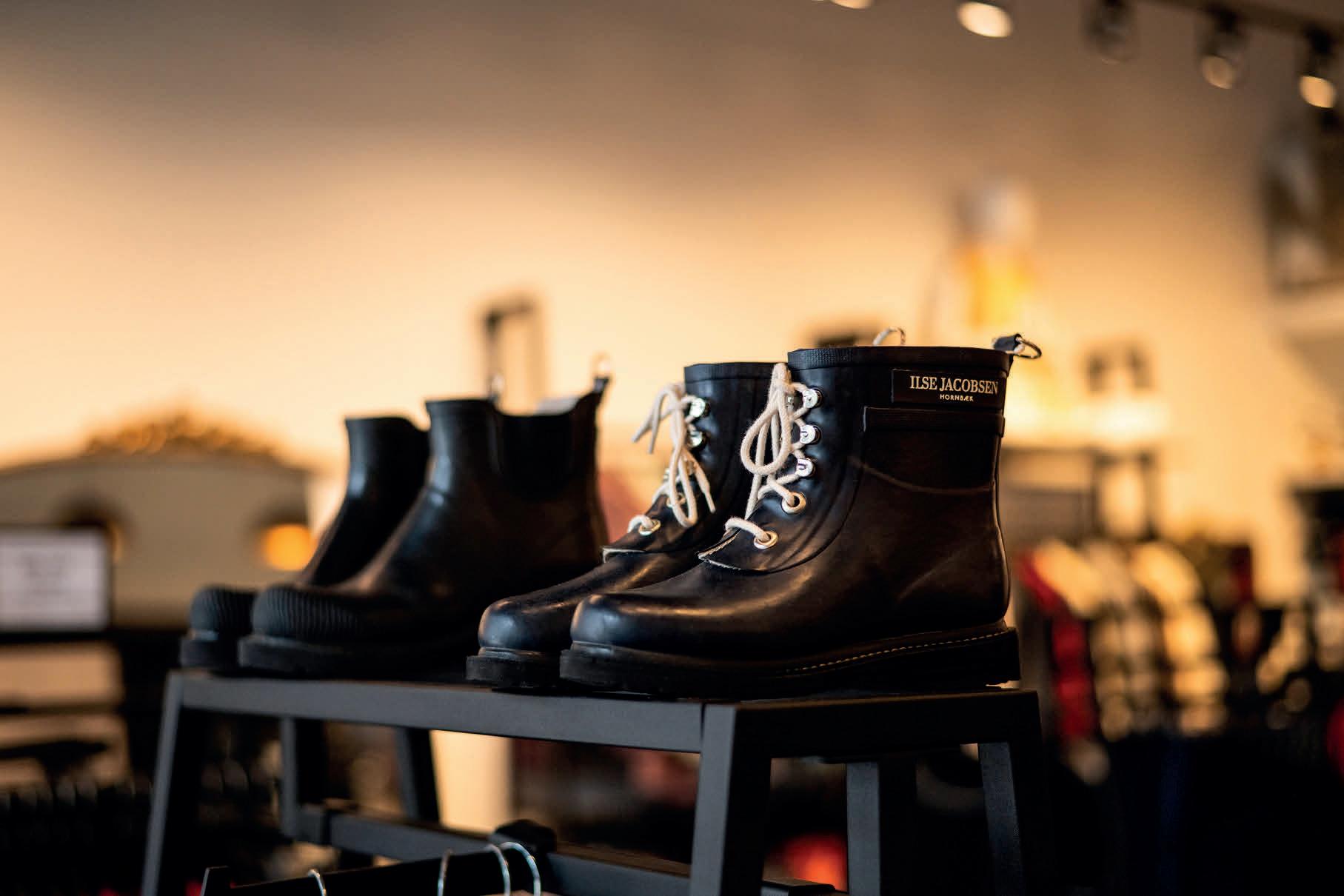







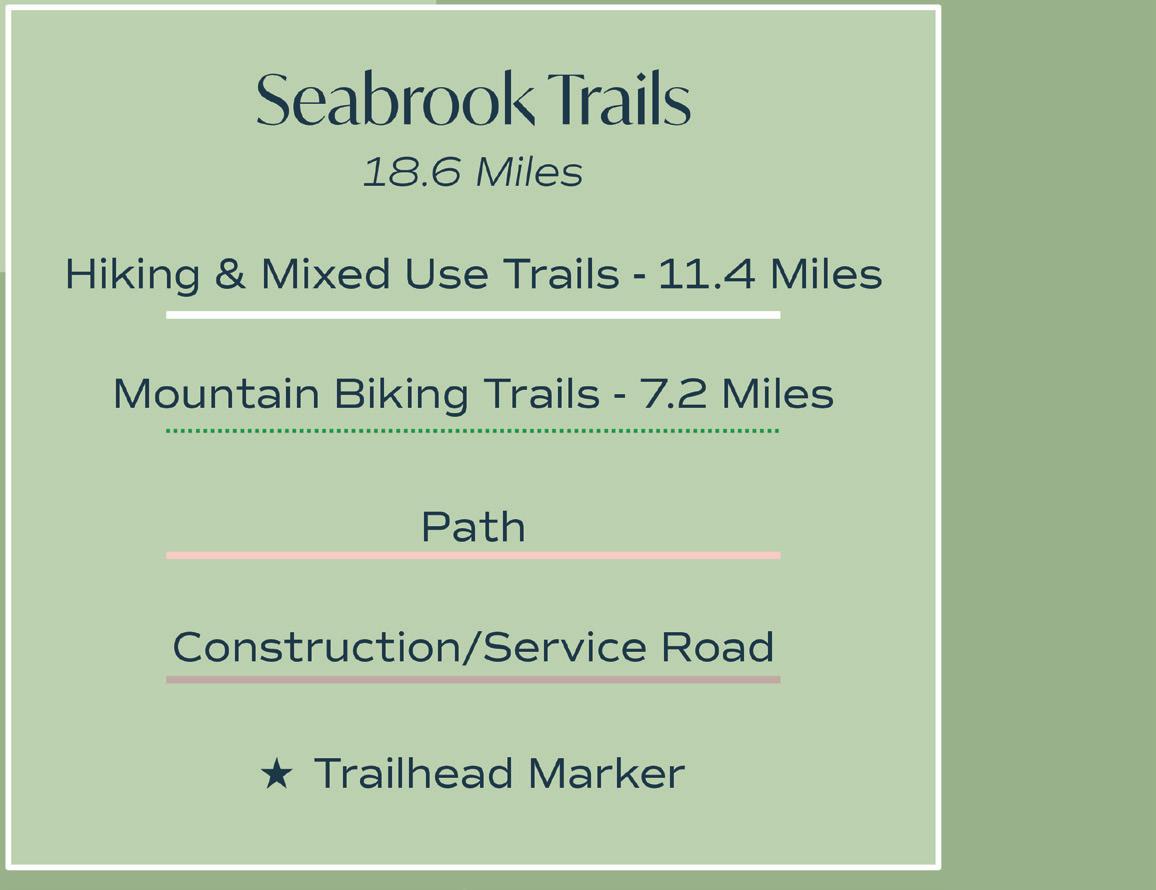


It was 115 years ago, on july 4, when this scene would have taken place—a group of visitors traveling to the westernmost terminus of the Northern Pacific Railway in Moclips, just north of Seabrook. Though this beautiful, wild section of the Pacific Northwest was obviously already inhabited by the Coast Salish peoples, the arrival of this station in 1905 put Moclips on the map as a destination for folks outside the area wanting to experience the Pacific Ocean for the first time. In some ways, everything has changed—in other ways, nothing at all. People continue to come here to experience the awe and delight of seeing where forest meets sea. In 2023, the Museum of the

North Beach had this mural painted by local artist Jenny Fisher to kick off an ongoing project to raise money towards developing a replica of the depot that will house the new permanent home of the museum, to continue to have a place for both longtime and former residents to catalogue and share their families’ North Beach experiences, with artifacts, documents, and oral stories. (In the meantime, you can find some of the museum’s exhibits in the Dorothy Anderson cabin on Meriweather Street.)
If you’d like to donate to the museum or get involved as a volunteer, please contact curator Kelly Calhoun (right) at kelly@moclips.org or board president Lee Marriott (left) at lee@moclips.org.






